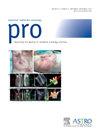Treatment Time and Dosimetric Advantage in Cone Beam Computed Tomography-Guided Online Adaptive Radiation Therapy Considering Interfractional and Intrafractional Changes in Patients With Gastric Mucosa-Associated Lymphoid Tissue Lymphoma
IF 3.4
3区 医学
Q2 ONCOLOGY
引用次数: 0
Abstract
Radiation therapy is the standard treatment for localized gastric mucosa-associated lymphoid tissue (MALT) lymphoma. The ETHOS system (Varian Medical System) has enabled us to perform cone beam computed tomography (CBCT)-guided online adaptive radiation therapy (oART). This study presents a retrospective dosimetric analysis for interfractional and intrafractional change and treatment time in oART for gastric MALT lymphoma. We included 3 male patients with gastric MALT lymphoma who underwent exhalation breath-hold fasting oART using the SpiroDynr'X system. Treatment details and plans (3 reference [REF] plans, 51 scheduled [SCH] plans, and adapted [ADP] plans) were retrospectively analyzed. Doses to the clinical target volume in planning CT (CTV_REF), CTV1, and CTV2 (representing the stomach in planning and preirradiation CBCT, respectively) and planning target volume (PTV) in the planning CBCT were estimated. D2%, D98%, D50%, and Dmean for these volumes, along with organ-at-risk doses, were examined across the 3 plans. The PTV dose coverage of CTV2 on preirradiation CBCT was calculated. CBCT-guided oART was completed within the scheduled period, using the ADP plans instead of the SCH plans on each treatment day in all cases. The average treatment time was approximately 45 minutes. CTV1 and CTV2 exhibited intrafractional and interfractional variations, fluctuating above and below CTV_REF. Some ADP plans resulted in incomplete PTV coverage of CTV2, but the unincluded volume was <1% of CTV2. D50%, D98%, and Dmean of CTV1, CTV2, and PTV were significantly improved in the ADP plans than in the SCH plans. Moreover, the Dmean to the liver and kidneys was reduced in the ADP plans. CBCT-guided oART in patients with gastric MALT lymphoma demonstrated that ADP plans improved CTV1, CTV2, and PTV doses and reduced the mean bilateral kidney and liver doses, suggesting that it may offer enhanced treatment precision for gastric MALT lymphoma.
考虑到胃MALT淋巴瘤患者的点间和点内变化,CBCT引导的在线自适应放疗的治疗时间和剂量优势。
目的:放射治疗是局部胃黏膜相关淋巴组织(MALT)淋巴瘤的标准治疗方法:放疗是治疗局部胃黏膜相关淋巴组织(MALT)淋巴瘤的标准疗法。ETHOS(瓦里安医疗系统)使我们能够进行锥束计算机断层扫描(CBCT)引导的在线自适应放疗(oART)。本研究对胃 MALT 淋巴瘤 oART 治疗中的点间和点内变化以及治疗时间进行了回顾性剂量学分析:方法:我们纳入了三名胃 MALT 淋巴瘤男性患者,他们使用 SpiroDynr'X 系统接受了呼气屏气禁食 oART 治疗。对治疗细节和方案(3 个参考方案[REF]、51 个预定方案[SCH]和适应方案[ADP])进行了回顾性分析。估算了计划 CBCT 中临床靶体积(CTV_REF)、CTV1、CTV2(分别代表计划 CBCT 和辐照前 CBCT 中的胃)和计划 CBCT 中计划靶体积(PTV)的剂量。检查了三个计划中这些体积的 D2%、D98%、D50% 和 Dmean 以及风险器官剂量。计算了辐照前 CBCT 上 CTV2 的 PTV 剂量覆盖范围:结果:CBCT引导下的oART在预定时间内完成,所有病例在每个治疗日都使用了ADP计划而不是SCH计划。平均治疗时间约为 45 分钟。CTV1 和 CTV2 出现了点内和点间变化,在 CTV_REF 上下波动。一些 ADP 计划导致 PTV 未完全覆盖 CTV2,但未覆盖的体积小于 CTV2 的 1%。与 SCH 计划相比,ADP 计划中 CTV1、CTV2 和 PTV 的 D50%、D98% 和 Dmean 都有明显改善。此外,ADP计划中肝脏和肾脏的Dmean值也有所降低:胃MALT淋巴瘤患者CBCT引导下的OART显示,ADP计划提高了CTV1、CTV2和PTV剂量,降低了双侧肾脏和肝脏的平均剂量,这表明它可以提高胃MALT淋巴瘤的治疗精度。
本文章由计算机程序翻译,如有差异,请以英文原文为准。
求助全文
约1分钟内获得全文
求助全文
来源期刊

Practical Radiation Oncology
Medicine-Radiology, Nuclear Medicine and Imaging
CiteScore
5.20
自引率
6.10%
发文量
177
审稿时长
34 days
期刊介绍:
The overarching mission of Practical Radiation Oncology is to improve the quality of radiation oncology practice. PRO''s purpose is to document the state of current practice, providing background for those in training and continuing education for practitioners, through discussion and illustration of new techniques, evaluation of current practices, and publication of case reports. PRO strives to provide its readers content that emphasizes knowledge "with a purpose." The content of PRO includes:
Original articles focusing on patient safety, quality measurement, or quality improvement initiatives
Original articles focusing on imaging, contouring, target delineation, simulation, treatment planning, immobilization, organ motion, and other practical issues
ASTRO guidelines, position papers, and consensus statements
Essays that highlight enriching personal experiences in caring for cancer patients and their families.
 求助内容:
求助内容: 应助结果提醒方式:
应助结果提醒方式:


